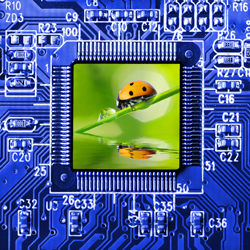Feature Stories - Every cloud has a green lining
Climate change dominates the political agenda, but we all still use an awful lot of energy, especially with our growing number of electronic devices. We have laptops and smart phones to charge and iPods to sync. We use the Internet for shopping, entertainment and education and easily forget that even a simple web search uses power. The market analyst firm IDC estimates that the digital universe had 1.8 zettabytes (one zettabyte is a billion terabytes; one terabyte is a thousand gigabytes) of information in 2011; they predict this to grow to 35 zettabytes by 2020. Within 15 years there will also be trillions of 'things' - devices, sensors, objects - connecting to the internet and flooding data centres with massive amounts of raw data that will have to be stored, processed and analysed. When seen in these terms it is perhaps less surprising to discover that a typical data centre consumes up to 20 megawatts (MW) of energy (a typical commercial wind turbine has an output of up to 1.5 MW). 'Server energy consumption and hardware costs are becoming a great concern in the data centres in which the servers are built,' says Dr. Emre Ozer, an R&D Staff engineer at chip technology company ARM. 'Cloud servers use high-end, expensive and energy-hungry processors and the chip manufacturers are now at the limit of what they can easily do to minimise energy wastage.' Serve up some greens Dr. Ozer is coordinating the EU-funded FP7 project 'The energy-conscious 3D server-on-chip for green cloud services', known as EuroCloud-"247779", which is looking into the potential for 3D server chips as one way to make them less energy hungry. EuroCloud-"247779" is one of Europe's flagship projects in Computing Systems. The idea is to embed processing cores and memory in close proximity and in three dimensions. Access to on-chip memory uses significantly less energy because the physical distances between components are shorter and there are fewer 'junctions' for electrons to cross on their journey from memory to processor. '3D chip technology has been around for a while, in particular in mobile computing where miniaturisation and energy efficiency are essential for devices. The main barrier to 3D chip technology becoming mainstream has been high manufacturing costs,' Dr. Ozer continues, 'but semiconductor companies are now investing in significant R&D to overcoming this hurdle.' So far the EuroCloud partners have developed their design concept for the new server-on-chip architecture. The project has also developed a framework for monitoring the thermal behaviour of 3D chips (their efficiency is closely coupled to how much heat they generate and how easy they are to keep cool). Chips in 'We have already shown that multiple servers on a chip design increases the server chip performance density by 15 % compared to existing server chip architectures built with today's technology,' explains Dr. Ozer. These early results are taken from simulations of chips containing multiple servers, but without integrated 3D memory. 'We are still in the process of measuring the chip performance density and energy to cost efficiency of multiple servers on a chip with integrated 3D memory,' he continues. 'Our target is to make these chips 10 times more energy-efficient.' Scaling this increased energy-efficiency to the data-centre level will result in huge energy savings. Having developed a 'proof of concept', the project hopes that the server-on-chip design will provoke the industry to develop server chips containing perhaps hundreds of embedded cores. ‘‘We expect that data centres with one million processors will one day become a reality,' predicts Dr. Ozer. 'We know we need them to meet the demand for cloud services, but we want to do it without a massive rise in energy consumption.' EuroCloud-"247779" received EUR 3.3 million (of total EUR 5.4 million project budget) in research funding under the EU’s Seventh Framework Programme (FP7), ICT 'Computing Systems' programme. Useful links: - 'The energy-conscious 3D server-on-chip for green cloud services' website(opens in new window) - Eurocloud factsheet on CORDIS Related articles: - 'Scale-out processors: bridging the efficiency gap between servers and emerging cloud workloads'



